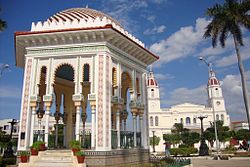Manzanillo, Cuba
| Manzanillo | |
|---|---|
| Municipality | |

The Glorieta of Manzanillo
|
|
 Manzanillo municipality (red) within Granma Province (yellow) and Cuba |
|
| Location of Manzanillo in Cuba | |
| Coordinates: 20°20′23″N 77°06′31″W / 20.33972°N 77.10861°WCoordinates: 20°20′23″N 77°06′31″W / 20.33972°N 77.10861°W | |
| Country |
|
| Province | Granma |
| Established | January 6, 1840 |
| Area | |
| • Total | 498 km2 (192 sq mi) |
| Elevation | 25 m (82 ft) |
| Population (2004) | |
| • Total | 130,789 |
| • Density | 262.6/km2 (680/sq mi) |
| Demonym(s) | Manzanillero/a |
| Time zone | EST (UTC-5) |
| Postal code | 87510 |
| Area code(s) | +53 23 |
Manzanillo is a municipality and city in the Granma Province of Cuba. By population, it is the 14th largest Cuban city and the most populated one not being a provincial seat.
It is a port city in the Granma Province in eastern Cuba on the Gulf of Guacanayabo, near the delta of the Cauto River. Its access is limited by the coral reefs of Cayo Perla.
The municipality is divided into the barrios of Primero, Segundo, Tercero, Cuarto, Quinto y Sexto (part of the city of Manzanillo), as well as the rural communities of Blanquizal, Calicito, Canabacoa, Caño, Ceiba Caridad, Congo, Jibacoa, Palmas Altas, Purial, Remate, Tranquilidad and Zarzal.
Manzanillo was founded in 1784. It was the site of during the Spanish American War. The settlement was sacked by the French in 1792, and in the following year a fort was built for its protection. In 1833 it received an ayuntamiento (council) and in 1837, for its “loyalty” in not following the lead of Santiago in proclaiming the Spanish Constitution, received from the crown the title of Fiel. In 1827 the port was opened to commerce, national and foreign.
The agriculture is based on raising coffee, sugar,rice, fruit and tobacco crops, as well as honey and cattle.
The industry is composed of sawmills, fish-canning, molasses plants, as well as some cigars and leather goods factories.
...
Wikipedia

